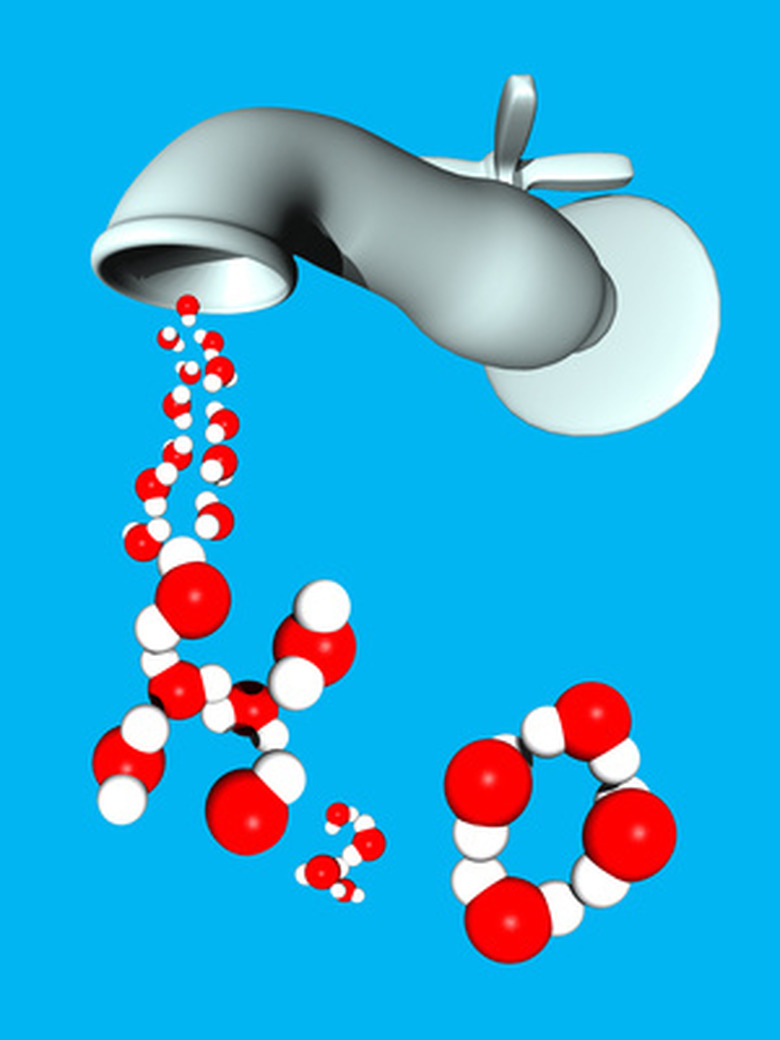Why Does Water Form Hydrogen Bonds?
There are two different chemical bonds present in water. The covalent bonds between the oxygen and the hydrogen atoms result from a sharing of the electrons. This is what holds the water molecules themselves together. The hydrogen bond is the chemical bond between the water molecules that holds the mass of molecules together. A drop of falling water is a group of water molecules held together by the hydrogen bonds between the molecules.
Hydrogen Bonding in Liquid Water
Hydrogen Bonding in Liquid Water
Hydrogen bonds are relatively weak, but since there are so many of them present in water, they determine its chemical properties to a large degree. These bonds are primarily the electrical attractions between positively charged hydrogen atoms and negatively charged oxygen atoms. In liquid water the water molecules have enough energy to keep them vibrating and moving around continuously. The hydrogen bonds are constantly forming and breaking, only to form once again. If a pan of water on a stove is heated, the water molecules move faster as they absorb more heat energy. The hotter the liquid, the more the molecules move. When the molecules absorb enough energy, those on the surface break free into the gaseous phase of steam. There is no hydrogen bonding in water vapor. The energized molecules are floating around independently, but as they cool down, they loose energy. Upon condensing, the water molecules are attracted to each other, and hydrogen bonds once again form in the liquid phase.
Hydrogen Bonding in Ice
Hydrogen Bonding in Ice
Ice is a well-defined structure, unlike water in the liquid phase. Each molecule is surrounded by four water molecules, which form hydrogen bonds. As the polar water molecules form ice crystals, they must orient themselves in an array like a three-dimensional lattice. There is less energy and therefore less freedom to vibrate or move around. Once they arrange themselves so that their attractive and repulsive charges are balanced, the hydrogen bonds set up in this manner until the ice absorbs heat and melts. The water molecules in ice are not packed as closely together as they are in liquid water. Since they are less dense in this solid phase, ice floats in water.
Water As a Solvent
Water As a Solvent
In water molecules the oxygen atom attracts the negatively charged electrons more strongly than the hydrogen. This gives water an asymmetrical distribution of charge so that it is a polar molecule. Water molecules have both positively and negatively charged ends. This polarity allows water to dissolve many substances that also have polarity or an uneven distribution of charge. When an ionic or polar compound is exposed to water, the water molecules surround it. Because the water molecules are small, many of them can surround one molecule of the solute and form hydrogen bonds. Because of the attraction, the water molecules can pull the solute molecules apart so that the solute dissolves in the water. Water is the "universal solvent" because it dissolves more substances than any other liquid. This is a very important biological property.
Water's Physical Properties
Water's Physical Properties
Water's network of hydrogen bonds gives it a strong cohesiveness and surface tension. This is evident if water is dropped onto wax paper. The water droplets will form beads since the wax is non-soluble. This attraction created by hydrogen bonding keeps water in a liquid phase over a wide range of temperatures. The energy required to break the hydrogen bonds causes water to have a high heat of vaporization so that it takes a large amount of energy to convert liquid water into its gaseous phase, water vapor. Because of this, sweat evaporation–which is used as a cooling system by many mammals–is effective because a large amount of heat must be released from an animal's body in order to break the hydrogen bonds between water molecules.
Hydrogen Bonding In Biosystems
Hydrogen Bonding In Biosystems
Water is a versatile molecule. It can hydrogen-bond to itself and also to any other molecules that have OH or NH2 radicals attached to them. This is important in many biochemical reactions. Its properties have made conditions favorable for life on this planet. A large amount of heat is required to raise water temperature one degree. This allows the oceans to store enormous amounts of heat and moderates the earth's climate. Water expands when it freezes, which has facilitated weathering and erosion on geological structures. The fact that ice is less dense than liquid water allows the ice to float on ponds. The top level of water can freeze and protect many life forms, which can survive the winter deeper in the water.
Cite This Article
MLA
Evans, Diane. "Why Does Water Form Hydrogen Bonds?" sciencing.com, https://www.sciencing.com/water-form-hydrogen-bonds-6465486/. 24 April 2017.
APA
Evans, Diane. (2017, April 24). Why Does Water Form Hydrogen Bonds?. sciencing.com. Retrieved from https://www.sciencing.com/water-form-hydrogen-bonds-6465486/
Chicago
Evans, Diane. Why Does Water Form Hydrogen Bonds? last modified August 30, 2022. https://www.sciencing.com/water-form-hydrogen-bonds-6465486/
